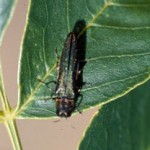Emerald Ash Borer: Treatment Options Exist for People Wanting to Save Trees
go.ncsu.edu/readext?379392
en Español / em Português
El inglés es el idioma de control de esta página. En la medida en que haya algún conflicto entre la traducción al inglés y la traducción, el inglés prevalece.
Al hacer clic en el enlace de traducción se activa un servicio de traducción gratuito para convertir la página al español. Al igual que con cualquier traducción por Internet, la conversión no es sensible al contexto y puede que no traduzca el texto en su significado original. NC State Extension no garantiza la exactitud del texto traducido. Por favor, tenga en cuenta que algunas aplicaciones y/o servicios pueden no funcionar como se espera cuando se traducen.
Português
Inglês é o idioma de controle desta página. Na medida que haja algum conflito entre o texto original em Inglês e a tradução, o Inglês prevalece.
Ao clicar no link de tradução, um serviço gratuito de tradução será ativado para converter a página para o Português. Como em qualquer tradução pela internet, a conversão não é sensivel ao contexto e pode não ocorrer a tradução para o significado orginal. O serviço de Extensão da Carolina do Norte (NC State Extension) não garante a exatidão do texto traduzido. Por favor, observe que algumas funções ou serviços podem não funcionar como esperado após a tradução.
English
English is the controlling language of this page. To the extent there is any conflict between the English text and the translation, English controls.
Clicking on the translation link activates a free translation service to convert the page to Spanish. As with any Internet translation, the conversion is not context-sensitive and may not translate the text to its original meaning. NC State Extension does not guarantee the accuracy of the translated text. Please note that some applications and/or services may not function as expected when translated.
Collapse ▲For current information about Emerald Ash Borer in North Carolina, please visit the NC Forest Service website.

Emerald Ash Borer
Photo Credit: Daniel Herms
Organization: The Ohio State University
In two years, the Emerald Ash Borer (EAB) has become a notorious pest in North Carolina. From its first appearance in the state in 2013, it has already left a trail of dead Ash trees in its wake, and it continues to spread, prompting a statewide quarantine in September. But, there are options for homeowners and landowners or land managers interested in protecting individual trees. “Treatment options are available, but because of the cost and accessibility of trees in a forest, it is simply not feasible to treat large forested areas,” said Rob Trickel, head of the N.C. Forest Service’s Forest Health Branch. “However, treatment of a few individual trees may be worth considering for some homeowners or landowners.”
Options for the urban or landscape/ornamental Ash tree include removing and replacing the Ash tree, or keeping the tree by treating it with pesticides. For those interested in keeping their Ash trees around, NCFS has developed an EAB Insecticide Guide. The guide was developed to assist even the newest of pesticide users with selecting and treating their Ash trees, covering common questions concerning tree identification, what pesticides can be used and how to make a pesticide application.
The guide lists 17 pesticides for EAB treatment that have been registered through the N.C. Department of Agriculture and Consumer Services Pesticide Section and also have been tested in field trials through universities or government agencies. Homeowners may also want to contact a certified arborist if they are uncertain about applying pesticides themselves or if their tree is large. “Generally, it is worth hiring an arborist if you want to protect Ash trees larger than 20” in diameter, but arborists can serve any size tree,” Trickel said.
To calculate your tree’s diameter, measure the width in inches around the tree at 4.5 feet above the ground. Divide that number by 3.14, and that will give you your diameter at breast height, or DBH. DBH is directly associated with the amount of pesticide applied to the tree and is often referred to on the insecticide label. A pesticide user will want to keep this number handy while measuring the chemical.
Another consideration is the cost of treatment. That is often a complicated issue, depending on many factors. There is an online Emerald Ash Borer Cost Calculator available through Purdue University that may assist landowners in making the decision.
Using the calculator will give you a side-by-side comparison of the cost to remove, remove/replace and treat with different pesticides. The calculator is free, but users must register a user name and password. “Generally speaking, the developers of the calculator assert that in most cases, it is more economical to protect Ash trees with pesticides than it is to replace them,” Trickel said.
For more information related to the research and science behind selecting an appropriate insecticide, the North Central Integrated Pest Management Center developed a publication, Insecticide Options for Protecting Ash Trees from Emerald Ash Borer. It is an extensive guide that answers many common questions.
For additional resources regarding ash trees in the urban environment, visit the N.C. Forest Service’s page, Managing Emerald Ash Borer in Urban Areas.
The N.C. Forest Service and the NCDA&CS Plant Industry Division continue to monitor the Emerald Ash Borer. If you suspect you have the insect, please contact your county ranger, call the NCDA&CS Plant Industry Division hotline at 1-800-206-9333, or email information to newpest@ncagr.gov.




